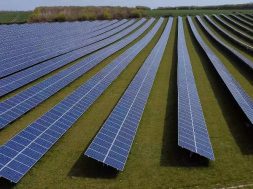
Advantages and Challenges of Overlapped-Cell Modules, Halfcut-Cell Modules and Bifacial Modules
Demand for PV products in 2017 has remained robust and relevant technologies have continued to advance. For instance, P-type mono-si PERC cell has become a mainstream technology at the high-efficiency market.
In addition, the technology to combine diamond-wire cut with black silicon process is reaching toward commercialization. EnergyTrend further estimates that overlapped-cell modules, halfcut-cell modules and bifacial modules are set to enter mass production in 2017.
Following are the advantages and challenges of the three types of module technology.
Halfcut-Cell Modules: overcoming yield rate issues
At the PV EXPO 2017 held in Tokyo, Japan, halfcut-cell modules took center stage with some Chinese, Taiwanese and Japanese exhibitors showcasing related products. Despite gaining much attention this year, the technology had been understated in previous years.
Halfcut-cell modules, as EnergyTrend analysts explained, are made by cutting regular solar cells in half and connecting them in a parallel formation. Resistance between the cells would decrease slightly, so the power output of a 60-cell module will generally be 5 watts higher than conventional one. In addition, using half-cut cell technology for packaging only incurs very limited additional cost, which is why it is widely adopted.
However, during assembly, there are more spots between busbar and ribbon that need to be soldered, so the possibility of soldering defects increases. This would further sacrifice yield rate. Nevertheless, with companies pouring resources into developing these modules, yield rate issues are expected to be overcome. EnergyTrend expects these modules can enter mass production in 2017.
Overlapped-Cell Modules: avoiding patent infringement
In late February, SunPower announced a joint development project of 5GW overlapped-cell module with DEC Dongfang Huanchen, meaning the technology has officially been backed by the leading global company.
An overlapped-cell module is a technology that joints PV cells together without very little or no gap; sometimes cells are even overlapped. This creates a fixed module area to deploy more cells so that more light can be absorbed and the overall power output will be enhanced by 10 to 15W. In addition, while assembling overlapped-cell modules, it requires almost no ribbon, which can reduce related costs.
However, producing overlapped-cell modules requires advanced technology in every stage. Firstly, individual cells need to be made as uniform as possible to ensure tight connections between cells. Moreover, it is also challenging for manufacturers to assemble each cell into a closely-spaced formation.
Starting from the second half of 2017, EnergyTrend predicts some manufactures may start producing overlapped-cell modules. However, during research and development, manufactures need to be mindful of patented technologies held by Chinese solar module manufacturerSeraphim and US solar company SunPower to avoid anyinstances of infringement.
Bifacial Modules: maintaining conversion efficiency on the front side
The above two modules can be described as new comers in the solar PV market. On the contrary, over the past two years, development of glass-to-glass and bifacial modules has already been underway and required technologies have been finalized in 2017. It is expected that demand for these modules will increase as broader applications of PV systems come on the market.
Among bifacial modules, P-type PERC cell is the most talked about technology since this year. China’s Trina Solar and Taiwan’s Neo Solar Power have already released P-type PERC bifacial cells. With PERC technology gradually takes root worldwide, more manufactures are expected to invest in bifacial PERC cells in the second half of 2017.
On the other hand, P-type bifacial PERC cell require adjusted manufacturing processes, and while the rear side of the cell can generate extra energy, it may impact the function of the passivated emitter rear layer, further reducing the conversion efficiency on the front side. As a result, the gain from the rear side does not seem to be beneficial as the total power output will not increase significantly. For companies developing P-type bifacial PERC cell, the greatest challenge lies in how to gain extra energy from the rear side of the cell without sacrificing the conversion efficiency on the front.
















